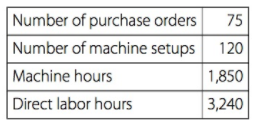Question: This problem is an adaptation of the example presented at the end of Chapter 2 for Custom Furniture Company. The only difference is that this

Transactions for the month of May are shown as follows:
1. Raw materials were purchased during the month for $15,000 on account
2. Raw materials totaling $21,000 were placed in production: $3,000 for indirect materials (glue, screws, nails, and the like) and $18,000 for direct materials (wood planks, hardware, etc.).
3. Timesheets from the direct labor workforce show total costs of $40,000, to be paid the next month.
4. Production supervisors and other indirect labor working in the factory are owed wages totaling $27,000.
5. The following costs were incurred related to the factory: building depreciation of $29,000, insurance of $11,000 (originally recorded as prepaid insurance), utilities of $4,000 (to be paid the next month), and maintenance costs of $22,000 (paid immediately).
6. Manufacturing overhead is applied to products based on the following cost driver activity for the month:

7. The following selling costs were incurred: wages of $5,000 (to be paid the next month), building rent of $3,000 (originally recorded as prepaid rent), and advertising totaling $10,000 (to be paid the next month).
8. The following general and administrative (G&A) costs were incurred: wages of $13,000 (to be paid the next month), equipment depreciation of $6,000, and building rent of $7,000 (originally recorded as prepaid rent).
9. Completed goods costing $155,000 were transferred out of work-in-process inventory.
10. Sold goods for $100,000 on account and $90,000 cash.
11. The goods sold in the previous transaction had a cost of $129,000.
12. Closed the manufacturing overhead account to cost of goods sold.
Required:
a. Calculate the predetermined overhead rate for each activity.
b. Prepare T-accounts for the following accounts: cash, accounts receivable, prepaid insurance, prepaid rent, raw materials inventory, work-in-process inventory, finished goods inventory, accumulated depreciation (building and equipment), accounts payable, wages payable, manufacturing overhead, sales, cost of goods sold, advertising expense (selling), rent expense (selling), wages expense (selling), depreciation expense (G&A), rent expense (G&A), and wages expense (G&A). Enter beginning balances in T-accounts for the inventory accounts (raw materials, work in process, and finished goods).
c. Prepare a journal entry for each of the transactions 1 through 11, and post each entry to the T- accounts set up in requirement b. Label each entry in the T-accounts by transaction number, and total each T-account.
d. Is overhead underapplied or overapplied for the month of May? Based on the balance in the manufacturing overhead T-account prepared in requirement c, prepare a journal entry for transaction 12.
e. Prepare an income statement for the month of May.
Estimated Annual Overhead Costs Estimated Annual Cost Driver Activity Activity Cost Driver 800 orders 1,000 setups 20,000 machine hours 38,000 direct labor hours $ 260,000 360,000 140,000 Purchase orders Machine setups Machine maintenance Misc. production activities Number of purchase orders Number of setups Machine hours Direct labor hours 380,000 $1,140,000 Total Number of purchase orders 75 Number of machine setups 120 Machine hours Direct labor hours 1,850 3,240
Step by Step Solution
3.46 Rating (159 Votes )
There are 3 Steps involved in it
a Predetermined overhead rates are calculated for each activity as follows a b a b Estimated Estimated Predetermined Overhead Cost Driver Overhead Activity Cost Driver Costs Activity Rate Purchase ord... View full answer

Get step-by-step solutions from verified subject matter experts
Document Format (2 attachments)
1592_6062c74cd1dbc_641482.pdf
180 KBs PDF File
1592_6062c74cd1dbc_641482.docx
120 KBs Word File


